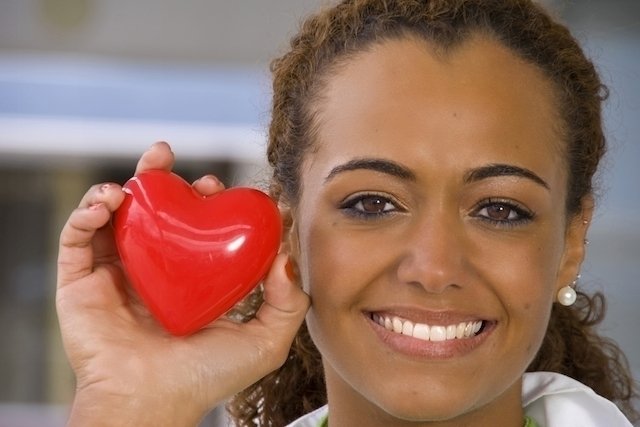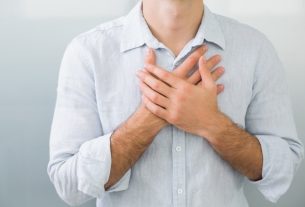The main symptoms of a female heart attack are a feeling of pressure or tightness in the chest, nausea, general malaise, excessive tiredness without an apparent cause, shortness of breath, discomfort in one or both arms, neck or chin and/or cold sweat.
Although the symptoms of female and male heart attacks are similar most of the time, less characteristic symptoms are more common in women and heart attacks can be confused with less serious problems, such as gastritis, gas or anxiety.
If a heart attack is suspected, it is advisable to seek emergency care. Even if it is not a heart attack, these symptoms may still indicate heart problems, and it is recommended to consult a cardiologist for an evaluation and start appropriate treatment. Check out the main symptoms of heart problems.
Learn how to recognize the symptoms of a heart attack in the following video:
Main symptoms
The main symptoms of a female heart attack are:
- Pain, discomfort, feeling of pressure or tightness in the chest;
- Nausea and general malaise;
- Excessive tiredness without apparent cause;
- Feeling of shortness of breath;
- Pain or discomfort in one or both arms, neck and/or chin;
- Cold sweat;
- Feeling empty-headed;
- Pain in the right shoulder;
- Pain in the stomach region.
These symptoms can appear without any physical effort or strong emotion, and can begin when the woman is resting and calm. Furthermore, they can appear together or separately, and can be confused with the beginning of a flu or digestion problem, for example, in some cases.
Although it is common for a female heart attack to cause symptoms that are less characteristic, most of the time, the symptoms of a heart attack in women are the same as those in men. Know the main symptoms of a heart attack.
What to do in case of a heart attack
If you suspect a heart attack, you should seek the nearest emergency room or call SAMU immediately, calling 192, because even if the symptoms are mild, a heart attack in women is also serious and can put their lives at risk.
If the heart attack worsens and there is loss of consciousness, it is important to seek help and start cardiac massage until the ambulance arrives. This attitude can save many lives. Learn how to do a cardiac massage.
Even if it is not a heart attack, symptoms such as nausea, vomiting and pain in the chest, neck or abdomen, especially when they worsen when exertion, may already indicate heart problems. Therefore, it is recommended to consult a cardiologist.
If you want to make an appointment, you can find the cardiologist closest to you using the tool below:
Early identification of heart problems and appropriate treatment, in accordance with your doctor’s instructions, can prevent a heart attack.
Possible causes of heart attack in women
The main causes of female heart attacks are:
- Atherosclerosis, which is the accumulation of fat in the artery walls;
- Coronary artery spasm, which is a sudden contraction that can happen in the heart arteries in some people;
- Clots in the blood circulation, which may arise due to changes in blood clotting, for example;
- Rupture of the heart arteries, also called spontaneous dissection of coronary arteries.
Although these causes are more common in women, the possible causes of a female heart attack are similar to those of a male heart attack. Better understand the main causes of heart attack.
Who is most at risk of having a heart attack
The risk of suffering a heart attack is higher in women over 50 years of age, sedentary and/or smokers, in case of diseases such as diabetes, high blood pressure or obesity and after menopause. Furthermore, frequent stress and the use of contraceptive pills can also increase the risk of heart attack.
Enter your data and find out if you have a high or low risk of developing cardiovascular diseases:
Therefore, all women with any of these risk factors should have at least one consultation with a cardiologist per year, especially after menopause.
Bibliography
- AHA. Angina in Women Can Be Different Than Men. Disponível em: <https://www.heart.org/en/health-topics/heart-attack/angina-chest-pain/angina-in-women-can-be-different-than-men>. Acesso em 05 jul 2023
- AHA. Heart Attack Symptoms in Women. Disponível em: <https://www.heart.org/en/health-topics/heart-attack/warning-signs-of-a-heart-attack/heart-attack-symptoms-in-women>. Acesso em 05 jul 2023
- MILLETT, Elizabeth R. C; MARK, Woodward. Sex differences in risk factors for myocardial infarction: cohort study of UK Biobank participants. BMJ. Vol.363. k4247, 2018
- AMERICAN COLLEGE OF CARDIOLOGY. Acute Myocardial Infarction in Women: AHA Statement. Disponível em: <https://www.acc.org/latest-in-cardiology/ten-points-to-remember/2016/01/26/15/08/acute-myocardial-infarction-in-women>. Acesso em 05 jul 2023
- MEHTA, Laxmi S. et al. Acute Myocardial Infarction in Women. Circulation. Vol.133. 916–947, 2016
- CHANDRASEKHAR, Jaya; GILL, Amrita; MEHAN, Roxana. Acute myocardial infarction in young women: current perspectives. Int J Womens Health. Vol.10. 267–284, 2018

Sign up for our newsletter and stay up to date with exclusive news
that can transform your routine!
Warning: Undefined array key "title" in /home/storelat/public_html/wp-content/plugins/link-whisper-premium/templates/frontend/related-posts.php on line 12
Warning: Undefined array key "title_tag" in /home/storelat/public_html/wp-content/plugins/link-whisper-premium/templates/frontend/related-posts.php on line 13




